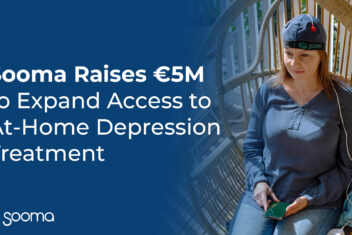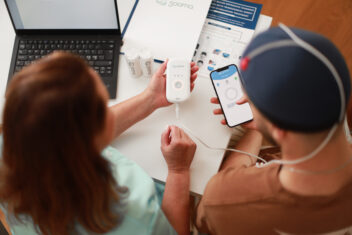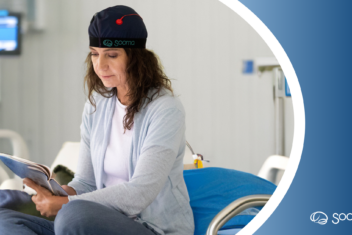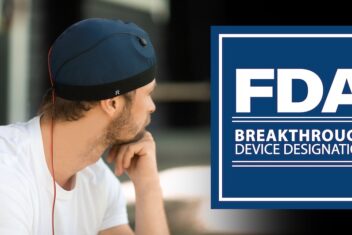Sooma Depression Therapy - An effective and safe option
See how it works
Prescribed by professionals, used at home
Sooma Depression Therapy
Sooma Depression Therapy is an effective noninvasive brain stimulation treatment with proven results. It uses a technique called transcranial direct current stimulation (tDCS), where a small portable medical device delivers electrical current to the prefrontal areas of the brain for 30 minutes at a time. The therapy is drug-free, and can be used either as a first-line of treatment or to bring additive effects to other forms of treatment. It is prescribed by a medical professional, but can easily be self-administered by patients themselves at their own home to the benefit of all. After repeating the stimulation once a day for three weeks, symptoms are relieved for the majority of patients.
Treatment outcomes in Sooma Depression Therapy
Sooma Depression Therapy has been used to treat thousands of patients worldwide in more than 30 countries. The latest publication of our treatment outcomes is based on 410 patients who’ve been treated either at a clinic or at home. Most patients were diagnosed with severe or moderate depression at baseline and were treated for approximately three weeks on average.
The response rate was 55%, which means that more than half of the patients experienced a minimum of 50% reduction in depressive symptoms from the treatment. From the patient perspective, the result helped the majority of patients to overcome severe work impairment and start getting back to regular routines.


What is tDCS?
Transcranial direct current stimulation (tDCS) is a noninvasive neuromodulation technique used to treat various psychiatric and neurological disorders. A weak electrical current is delivered from a portable device to targeted areas of the brain. This causes polarity-dependent changes in the electrical signalling of the brain.
In depression, the current is delivered to the prefrontal areas of the brain in order to modulate their activity. The goal is to normalise
1. the hypoactivity of the left dorsolateral prefrontal cortex (DLPFC), and
2. the hyperactivity of the right DLPFC.
Why use tDCS to treat depression?
The effects of tDCS have been studied for at least three decades. The most recent meta-analysis (N = 1092) of tDCS in depression found active tDCS to be superior to sham tDCS both in terms of endpoint depression scores and response and remission rates.
tDCS is not associated with any serious adverse effect. A safety review based on over 40,000 stimulation sessions concluded tDCS to be a safe treatment method, also when used in adolescent or elderly patients.
Several patients have reported increased activity and better functionality in daily life and improvements in terms of work impairment.
To access the different publications, visit our Knowledge Centre.



Treatment protocol
A Sooma Depression Therapy session lasts for 30 minutes and is conducted daily for 3 weeks. The treatment uses a 2mA current and stays level throughout the session aside from a short ramp-up and ramp-down at the start and end of the session. When 30 minutes have passed, the device ends the session automatically.

Steps to getting started with Sooma Depression Therapy
Contact us and our team will be happy to provide the correct solution for your needs. We work together with a wide network of distributors to ensure that you receive equipment in a timely manner, and can get onsite support in your local language.
We will train all our customers how to conduct Sooma therapies. This is of paramount importance to achieve the optimal treatment results learning about:
1. Background of the therapy
2. How to pick correct patients for the therapy
3. How to select and adjust the treatment protocol
4. How to use the system, and teach patients to use it
Step 1: Preparations before treatment
Meet with the patient and gather the relevant medical information. Make sure that the patient is eligible for the treatment, and determine the patient’s baseline depression score using the depression scale of your choice (for example BDI, HAMD, MADRS). Go through the loaner agreement and make sure the patient has signed, then lend the device and accessories to the patient. If treatment is done 100% remotely, the first meeting can be done over video, after which the equipment can be picked up by the patient, or shipped.

Step 2: Starting treatment
Normally, the first treatment session is conducted in the clinic and administered by a nurse. Here, the nurse may also instruct the patient on how to self-administer the treatment when at home. Make sure the patient has relevant instructions and materials for the treatment period (these are provided by Sooma). If the treatment is done 100% remotely, then ideally instruct and observe the patient's preparation and self-administration of the first treatment session over a video call in order to make sure that the treatment is done correctly.

Step 3: During treatment
During the treatment period, we recommend having weekly phone calls or messages with the patients to follow-up on their progress and compliance. At the end of the treatment period, the patient normally comes back to the clinic to get the results evaluated by the doctor. Assess the patient's new depression score through a new BDI/MADRS/HAMD form, and decide on whether to continue the treatment. If yes, supply with more disposables, if no, have the patient to return the equipment. If the treatment is done 100% remotely, we recommend calling the patient at the end of the treatment period to evaluate the results over phone or video.

FAQ (Frequently asked questions)
What is tDCS and what happens in the brain?
To read more about tDCS and what happens in the brain, visit this BLOGPOST.
How does this differ from ECT?
Sooma Depression Therapy applies a weak direct current to specific regions of the brain for tens of minutes in order to gradually change the electrical signalling in the brain. ECT uses ultra-brief alternating current to induce a seizure in the brain. The peak current is up to 500 times larger than in Sooma Depression Therapy and results in completely different biological reactions in the brain.
Are there any contraindications?
While Sooma Depression Therapy is safe when used correctly, there are specific risk groups where caution should be used. If the patient has metal within the skull or an implanted life-supporting medical device in the body, the therapy should not be used. Further, if the skin under the electrodes is broken or diseased, the stimulation should not be applied.
Are there other psychiatric conditions where this would help?
There are ongoing research in many psychiatric conditions, and we have also seen improvements in some secondary conditions when treating depression. There is, however, not enough evidence to claim efficacy to other conditions at this point. You can get in touch with us to discuss a specific condition.
Where can I read more?
We have collected relevant, high-quality studies in our Knowledge Centre. If you have a specific question you'd like to read more about, please contact us, and we'll help to find the correct resource. You may also subscribe to our newsletter (see footer) to get updates on the most recent science in the field.
Enquiry form
Please note that Sooma tDCS is sold only to medical professionals. If you are a patient wishing to receive tDCS treatment, please inquire your physician about the possibility or fill out our contact form and we can help you find a provider.




